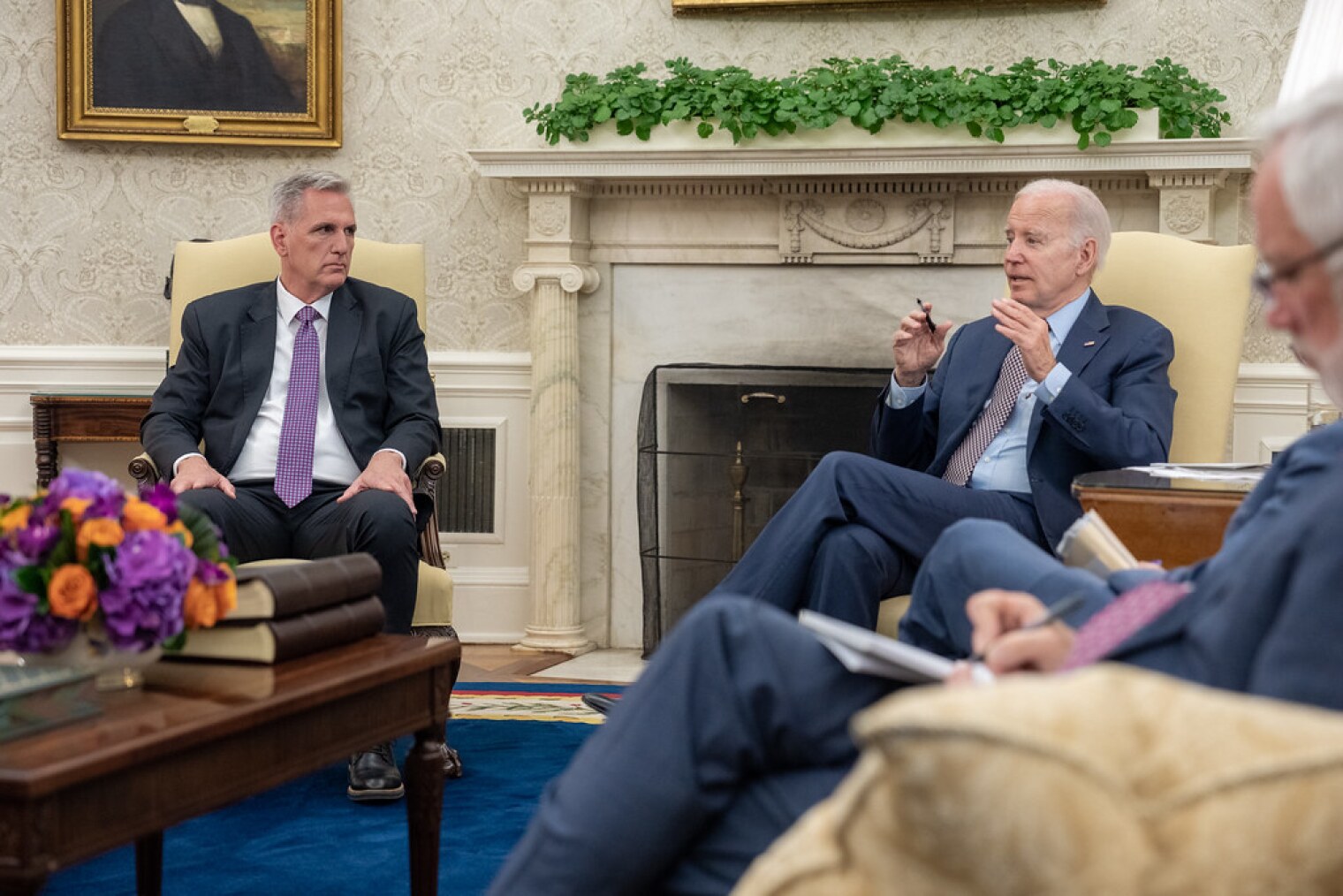| |
| FYI: Science Policy News from AIP |
| THIS WEEK |
|
|
|
|
|
|
| What’s Ahead |
 |
| House Speaker Kevin McCarthy (R-CA) negotiated caps on federal spending with President Joe Biden in May, but a group of House Republicans are now pushing to cut spending below the caps, clouding the outlook for a final agreement. Adam Schultz/White House |
Shutdown Fears Loom Over September Budget Negotiations
When Congress returns from its August recess after Labor Day, lawmakers face the urgent task of negotiating a stopgap spending measure to avert a government shutdown at the end of the fiscal year on Sept. 30. While Congress routinely uses stopgaps to buy time to reach a final agreement on agency spending levels, this year a group of right-wing House Republicans are threatening to oppose the measure unless it includes provisions reflecting their policy priorities, which Democrats are unlikely to accept.
Reaching a final agreement will also be made more difficult by House Republicans’ aim of cutting agency budgets well below the overall spending caps that President Biden and House Speaker Kevin McCarthy (R-CA) negotiated for the fiscal year. Meanwhile, the Senate has advanced bipartisan spending legislation that exceeds the caps by adding more than $10 billion in “emergency” spending, some of which is for science programs. The Biden administration has also requested Congress provide around $40 billion in additional emergency spending largely related to disaster relief and the war in Ukraine.
Japan Set to Launch X-Ray Astronomy Mission
JAXA, Japan’s space agency, is aiming to launch its X-Ray Imaging and Spectroscopy Mission as soon as Thursday after it scrubbed its first launch attempt at the beginning of this week due to adverse weather conditions. XRISM (pronounced “crism”) is designed to provide unprecedented X-ray spectroscopic resolution that will enable new research on the structure and formation of the universe, the evolution of galaxy clusters, and the circulation of energy in the cosmos. NASA has contributed over $100 million to the mission’s development, primarily by supplying one of its two instruments, a soft X-ray spectrometer called Resolve, and will also contribute to post-launch operations. JAXA built XRISM after a similar observatory it launched in 2016 called Hitomi broke apart early in its mission due to a software error that caused it to tumble out of control. JAXA’s small-scale SLIM (Smart Lander for Investigating Moon) mission will launch on the same rocket as XRISM and, if successful, it will be Japan’s first mission to safely reach the lunar surface.
|
|
| In Case You Missed it |
 |
| India’s Chandrayann-3 lunar rover left these tracks after it reached the lip of a crater and had to turn around to explore in a different direction. (ISRO) |
ISRO Accomplishes First Landing Near Lunar South Pole
India successfully landed its Chandrayaan-3 mission in the south polar region of the Moon last Wednesday. The mission, comprising a rover and its landing craft, is expected to continue for about 14 days, until the Sun sets on the landing site. The landing comes just a week after a Russian landing attempt, also targeting the Moon’s south polar region, ended in failure. The region is of significant interest due to the water ice that exists in permanently shadowed craters there, but it is a harder location to reach than other parts of the Moon. Reportedly costing about $75 million, Chandrayaan-3 is part of an international scramble to reach the lunar surface on low budgets. NASA’s Commercial Lunar Payload Services program, which is also part of that drive, is currently scheduled to make its first landing attempts later this year following repeated delays.
US Buying Time to Renegotiate Science Agreement With China
Just before the Aug. 27 expiration of the U.S.–China Science and Technology Cooperation Agreement, the State Department indicated it would seek to negotiate new terms while extending the existing terms for six months. A department spokesperson told NBC News, “We are clear-eyed to the challenges posed by the People’s Republic of China’s national strategies on science and technology, Beijing’s actions in this space, and the threat they pose to U.S. national security and intellectual property and are dedicated to protecting the interests of the American people.” On the same day the department disclosed its interest in extending the agreement, three Republican members of the House Select Committee on the Chinese Communist Party introduced legislation proposing that any S&T agreements between the U.S. and China be subject to congressional review. Meanwhile, prominent scientists rallied in support of extending the agreement, with over 1,000 signing a petition organized by Stanford University physicists Steven Kivelson and Peter Michelson.
PCAST Seeks Reforms to Nanotechnology Initiative Oversight
Last week, the President’s Council of Advisors on Science and Technology issued its seventh congressionally mandated review of the National Nanotechnology Initiative. PCAST’s main recommendation is that the federal government “sunset or substantially revise” the 21st Century Nanotechnology R&D Act of 2003 that established oversight structures for the NNI, which the U.S. launched in 2000. PCAST argues that “the federal coordination structure required for the emergence of nanotechnology in the early 2000s needs to evolve to reflect nanotechnology’s maturation and broad relevance.” It suggests, for instance, ending the act’s mandated periodic reviews of the initiative and the annual NNI supplement to the president’s budget request. It also recommends that the Nanoscale Science, Engineering, and Technology Subcommittee of the National Science and Technology Council play a bigger role in coordinating the initiative. Turning to workforce development needs, PCAST suggests that agencies on the subcommittee do more to promote multidisciplinary “experiential learning programs.”
|
|
| Upcoming Events |
|
All times are Eastern Daylight Time, unless otherwise noted. Listings do not imply endorsement.
Monday, August 28
Tuesday, August 29
Wednesday, August 30
Thursday, August 31
Friday, September 1
Tuesday, September 5
Know of an upcoming science policy event either inside or outside the Beltway? Email us at fyi@aip.org.
|
|
| Opportunities |
NSF Hiring Leads for New Technology Directorate
The National Science Foundation is hiring heads for the Emerging Technologies Section and the Innovation Programs Section in its recently created Directorate for Technology, Innovation, and Partnerships. The emerging technologies unit is responsible for developing key technologies identified by the CHIPS and Science Act, and the innovation unit works to foster regional innovation ecosystems through NSF’s new “Engines” program. Applications are due Aug. 31.
National Academies Seeking Mirzayan Policy Fellows
The National Academies has opened applications for the spring 2024 cohort of the Christine Mirzayan S&T Policy Graduate Fellowship Program. Fellows work full-time for 12 weeks across policy units of the Academies. The fellowship is open to early-career scientists, engineers, and medical professionals and late-stage graduate students. Applications are due Oct.16.
DOE Renewables Office Seeking Strategic Analysis Fellows
The Department of Energy’s Office of Energy Efficiency and Renewable Energy is seeking applications for its strategic analysis fellowship. Fellows will work on projects “pertaining to the performance, costs, benefits, challenges, and opportunities of clean energy technologies.” Candidates must be pursuing or have a master’s or doctoral degree. The fellowship will last one year, with the possibility of extension.
Know of an opportunity for scientists to engage in science policy? Email us at fyi@aip.org.
|
|
| Around the Web |
|
News and views currently in circulation. Links do not imply endorsement.
White House
Congress
Science, Society, and the Economy
Education and Workforce
Research Management
Labs and Facilities
Computing and Communications
Space
Weather, Climate, and Environment
Energy
Defense
Biomedical
International Affairs
|
|
|
| |
| This message is sent to you because your email address is on our subscribers list. To manage your FYI preferences and subscriptions, please click here . Or you can unsubscribe from all emails from AIP. AIP, 1 Physics Ellipse, MD 20740-3841
301.209.3100 - newsletters@aipcomm.org As a 501(c)(3) non-profit, AIP is a federation that advances the success of our Member Societies and an institute that engages in research and analysis to empower positive change in the physical sciences. The mission of AIP (American Institute of Physics) is to advance, promote, and serve the physical sciences for the benefit of humanity. |
|
| © 2024. American Institute of Physics |
|
|